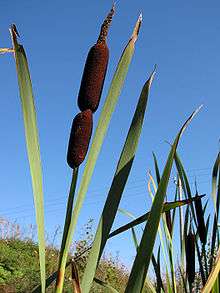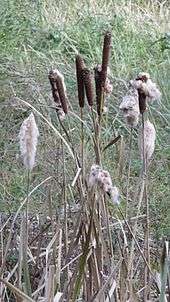Typha latifolia
Typha latifolia (broadleaf cattail,[4] bulrush, common bulrush, common cattail, cat-o'-nine-tails, great reedmace, cooper's reed, cumbungi) is a perennial herbaceous plant in the genus Typha. It is found as a native plant species in North and South America, Europe, Eurasia, and Africa.[5] In Canada, broadleaf cattail occurs in all provinces and also in the Yukon and Northwest Territories, and in the United States, it is native to all states except Hawaii.[6][7] It is an introduced and invasive species, and is considered a noxious weed, in Australia and Hawaii.[8] It has been reported in Indonesia, Malaysia, New Zealand, Papua New Guinea, and the Philippines.[5]
| Typha latifolia | |
|---|---|
 | |
| Mature male flower spike of Typha latifolia; female flower spike beneath it is still green (immature) | |
| Scientific classification | |
| Kingdom: | Plantae |
| Clade: | Tracheophytes |
| Clade: | Angiosperms |
| Clade: | Monocots |
| Clade: | Commelinids |
| Order: | Poales |
| Family: | Typhaceae |
| Genus: | Typha |
| Species: | T. latifolia |
| Binomial name | |
| Typha latifolia | |
| Synonyms[2][3] | |
|
Synonyms list
| |
Typha latifolia has been found in a variety of climates, including tropical, subtropical, southern and northern temperate, humid coastal, and dry continental.[7] It is found at elevations from sea level to 7,500 feet (2,300 m).
Typha latifolia is an "obligate wetland" species, meaning that it is always found in or near water.[9] The species generally grows in flooded areas where the water depth does not exceed 2.6 feet (0.8 meters).[10] However, it has also been reported growing in floating mats in slightly deeper water.[7] T. latifolia grows mostly in fresh water but also occurs in slightly brackish marshes.[9] The species can displace other species native to salt marshes upon reduction in salinity. Under such conditions the plant may be considered invasive, since it interferes with preservation of the salt marsh habitat.[9]
Typha latifolia shares its range with other related species, and hybridizes with Typha angustifolia, narrow-leaf cattail, to form Typha × glauca (Typha angustifolia × T. latifolia), white cattail.[7] Common cattail is usually found in shallower water than narrow-leaf cattail.
The plant is 1.5 to 3 metres (5 to 10 feet) high and it has 2–4 cm (¾ to 1½ inch) broad leaves, and will generally grow out in to 0.75 to 1 metre (2 to 3 feet) of water depth.
Uses
Traditionally, Typha latifolia has been a part of certain indigenous cultures of British Columbia, as a source of food, medicine, and for other uses. The rhizomes are edible after cooking and removing the skin, while peeled stems and leaf bases can be eaten raw, or cooked. The young flower spikes, young shoots, and sprouts at the end of the rootstocks are edible as well.[11][12] The starchy rootstalks were ground into meal by Native Americans.[12]
While Typha latifolia grows all over, including in rural areas, it is not advisable to eat specimens deriving from polluted water as it absorbs pollutants and in fact is used as a bioremediator. Specimens with a very bitter or spicy taste should not be eaten.[13]
Images
| Wikimedia Commons has media related to Typha latifolia. |



- Cross section of plant's pseudostem, formed of overlapping leaf bases
References
- Lansdown, R.V. (2014). "Typha latifolia". IUCN Red List of Threatened Species. 2014. Retrieved 28 May 2010.CS1 maint: ref=harv (link)
- Tropicos, Typha latifolia
- The Plant List, Typha latifolia
- "Typha latifolia". Natural Resources Conservation Service PLANTS Database. USDA. Retrieved 12 December 2015.
- "Typha latifolia (aquatic plant)", Global Invasive Species Database. Retrieved 2011-02-21.
- Flora of North America vol 22 p 282.
- "Typha latifolia, U.S. Forest Service Fire Effects Information Database", U.S. Forest Service. Retrieved 2011-02-20
- "Typha latifolia (Typhaceae) Species description or overview", Hawaiian Ecosystems at Risk project (HEAR). Retrieved 2011-02-21.
- "USDA Plant Guide: Typha latifolia", United States Department of Agriculture. Retrieved 2011-02-20.
- "Broadleaf Cattail", Utah State University Cooperative Extension. Retrieved 2011-02-20.
- Turner, Nancy J. Food Plants of Interior First Peoples (Victoria: UBC Press, 1997) ISBN 0-7748-0606-0
- Niering, William A.; Olmstead, Nancy C. (1985) [1979]. The Audubon Society Field Guide to North American Wildflowers, Eastern Region. Knopf. p. 810. ISBN 0-394-50432-1.
- YouTube - Wild Living with Sunny: episode 4 Video describing collection and cooking of common cattail.
External links
- ROOK description
- Edibility of Cattail - Edible parts and identification of Typha latifolia.
- U. of Michigan-Dearborn: Ethnobotany
